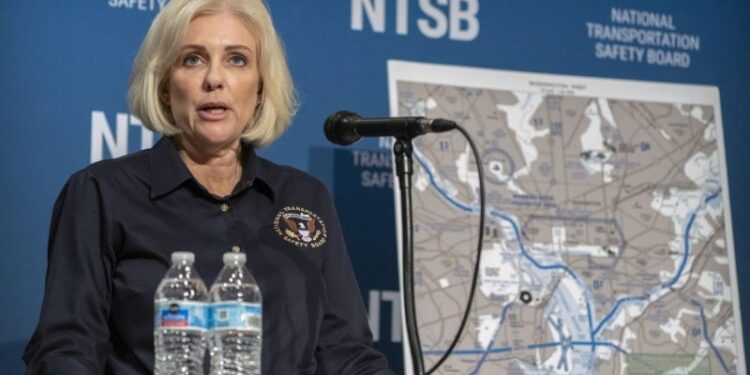
(The Hill) — The Black Hawk pilots who collided with an American Airlines plane last month may not have heard vital information given by air traffic control to fly behind the passenger jet seconds before the crash, the National Transportation Safety Board (NTSB) revealed Friday.
Seventeen seconds before impact, a radio transmission from the control tower directed the Black Hawk to pass behind the jet. But data from the Army helicopter indicated that “the portion of the transmission that stated ‘pass behind the’ may not have been received by the Black Hawk crew,” NTSB Chairwoman Jennifer Homendy said at a Friday news conference.
It is likely the Black Hawk pilots “stepped on” the communication for less than a second by pressing the microphone key to communicate back to the control tower, she said.
Furthermore, the Black Hawk pilots may have had “bad data” on the altitude they were flying at outside Washington D.C. at the time of the Jan. 29 collision, which killed all 67 people aboard both flights, according to the agency.
The Black Hawk crashed into Flight 5342 just before 9 p.m. as the jet was en route to Reagan National Airport from Wichita, Kan. The collision sent both aircraft plunging into the Potomac River, the deadliest such accident since 2001.
“We are seeing conflicting information in the data,” Homendy said, noting that the helicopter was flying at 278 feet when it crashed — far above the 200-foot limit for that location.
But “that does not mean that’s what the Black Hawk crew was seeing on the barometric altimeters in the cockpit,” she cautioned.
At one point, the pilot indicated they were flying at 300 feet, but the instructor pilot said they were at 400 feet, according to recordings.
“We are looking at the possibility that there may be bad data,” she said.
Investigators also believe the helicopter pilots were wearing night vision goggles and had been the whole flight.
She said that the on-scene phase of the investigation into the disaster had been finished, but because of the conflicting data with the Black Hawk’s altitude, the NTSB is not yet releasing information for the helicopter’s entire route.
Earlier this month, the Federal Aviation Administration ruled that helicopters and airplanes would no longer be able to share the airspace above the Potomac River, a decision made after speculation the Black Hawk had been flying too high.
The accident has also prompted widespread concern over the staffing shortages at the FAA with President Trump vowing to overhaul the agency and air traffic control.






